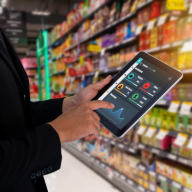Retail's new fork in the road

Retail
341 week ago — 7 min read
It is all too easy to be misled by high-level statistics and narratives that paint an incomplete picture of the retail landscape. Similarly, many fail to appreciate the underlying dynamics that (increasingly) separate industry winners from the losers, and that which will ultimately determine when online shopping starts to mature. Much of this, I believe, can be understood by focusing on the difference between ‘buying’ and ‘shopping’.
I’m hardly the first to make this distinction. Entrepreneur and blogger Seth Godin got me thinking about this with his 2015 post. Since then, it has become more and more clear to me that delving into the differences is extremely useful in ascertaining what is next for the retail industry.
Understanding ‘buying’
Buying is mostly transactional. More mission, than journey. More search, than discovery. Most times buying tilts toward being need-driven rather than motivated by want. At the heart of buying is efficiency. When we are in buying mode, we care primarily about speed, convenience and a broad, yet easy to navigate, assortment. Buying tends to be highly-value driven. When transacting digitally, it must be easy to compare prices. When buying at brick & mortar stores, customers come to learn which brands consistently deliver the best value and often start their process with these favourite stores.
With this lens, it should be easy to see that e-commerce is optimised for buying. The categories that do the best online are those where there is a strong, though not necessarily exclusive, buying dynamic. Unsurprisingly, this is where Amazon has the greatest market share and growth. When it comes to being remarkable in the realm of buying, much of it is about eliminating friction in the path to efficiency, be that on price, assortment and/or convenience.
Understanding ‘shopping’
Shopping is far more experiential. When shopping, customers fundamentally enjoy the process of exploring and discovering, whether online or at a store. It can be highly social and takes more time. The value is in finding just the right item, the right outfit or solving a more complicated problem—like furnishing a room or completing a home improvement project. When shopping, typically the risk of making a mistake is greater, so the ability to get sales help, shop with friends, try something on, touch and feel the product, and so on, is paramount.
While a strong digital presence can greatly facilitate the shopping process, the share of online shopping is dramatically lower than online buying. Categories with strong shopping characteristics (higher-end home furnishings, fashion apparel, non-commodity grocery items like produce and meat, etc.) have very low e-commerce shares.
Apocalypse no
There really is no retail apocalypse, but certain sectors of retail are clearly being radically transformed. Much of this can be best understood by understanding the difference between buying and shopping. By far the greatest disruption is occurring where buying is being reinvented, online and offline. The first wave of massive share shift occurred in the buying of entertainment when music, books and games could be digitally downloaded. This wave was, in fact, apocalyptic to the likes of Babbage’s, Barnes & Noble, Blockbuster and Borders—and that’s just the Bs. More recently, platform businesses like Alibaba and Amazon have made the buying process far more efficient in many categories, leading to major market share gains and the demise (or teetering on the brink) of many brands that could not keep pace. But let’s be clear: Amazon is not ‘the everything store’. It is, however, quickly becoming the anything-you-want-to-‘buy’ store. In the absence of a far greater brick & mortar presence, Amazon will continue to struggle in its quest to dominate shopping.
Innovation and growth in ‘buying’ has occurred outside of the purely digital world. Brands such as Aldi, Lidl, Dollar General, Ross, TJX and others have re-worked and expanded their business model by delivering greater than ever ‘buying’ value. If there is a retail apocalypse, someone needs to tell these brands. They will collectively add thousands of new stores this year alone.
The same is true in the ‘shopping’ world. Sephora, Ulta, Apple and many others that continue to offer a remarkable shopping experience are growing both online and offline. Moreover, many high profile pureplay e-commerce players have basically started to run out of customers that would approach their brands in ‘buying’ mode and thus they needed to go seek out ‘shoppers’ with brick & mortar locations. In fact, several of them once stated that they would never open stores. This is because they didn’t understand how the buying vs. shopping dynamic would inevitably play out over time. It now turns out that Warby Parker, Peloton and Bonobos are seeing the majority of their incremental growth come from their physical locations.
Stuck in the middle with you
It’s increasingly untenable to attempt to stake out a middle ground between buying and shopping. The middle is collapsing. Trying to be sort of good at serving the customer who is firmly in buying mode is like being sort of pregnant. Being boring and unremarkable for customers in shopping mode is equally foolhardy.
The fork in the road
Certainly not every brand or every category has a clear cut, all or nothing, buying vs. shopping pattern. But it’s critically important to understand how this plays out for each and every retailer. While the ridiculous amount of debt Toys“R”Us amassed was the proximate cause of their downfall, a strategic and financial crisis was inevitable as they wrong-headedly decided to be more about buying than shopping. Many struggling brands are similarly confused. This will not end well. The fact is retailers must choose a clear path. If a retailer wishes to grab share (or insulate themselves) from the Amazon buying tsunami than it is pretty clear what that implies. Good luck and Godspeed.
If a retailer wishes to re-imagine their business model to become a more remarkable shopping experience than that is an entirely different thing.
Choose wisely. Pick a lane. Step on the gas.
Article by Steve Dennis published in STOrai Magazine. Steve Dennis is a consultant, speaker and writer on retail innovation, omni-channel strategy and marketing personalisation.
Disclaimer: The views and opinions expressed in this article are those of the author and do not necessarily reflect the views, official policy or position of GlobalLinker.
Network with SMEs mentioned in this article
View STOrai 's profile
Other articles written by STOrai Magazine
The Art & Science of People Pleasing in Retail
10 week ago
Most read this week














Comments (1)
Share this content
Please login or Register to join the discussion